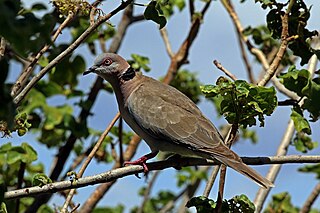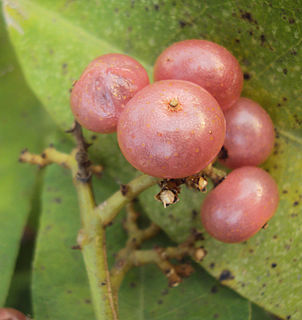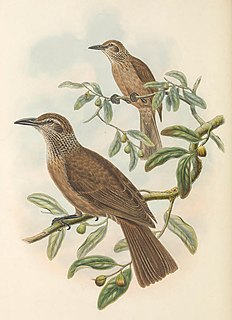
The mourning collared dove or African mourning dove is a dove which is a widespread resident breeding bird in Africa south of the Sahara. Despite its name, it is not related to the North American mourning dove. This species is common or abundant near water. They often mingle peacefully with other doves.
Millettia decipiens is a species of legume in the family Fabaceae. It is a tree endemic to Peninsular Malaysia. It is threatened by habitat loss.

Dypsis decipiens, the Manambe palm, is a species of flowering plant in the family Arecaceae. It is found only in the central highlands of Madagascar, between Fianarantsoa and Andilamena. The species is threatened by habitat loss, increasing frequency of fires, and over-exploitation of its seeds for the horticultural trade.
Orania decipiens is a species of flowering plant in the family Arecaceae. It is found only in the Philippines.
Achatinella decipiens is a species of air-breathing land snail, a terrestrial pulmonate gastropod mollusk in the family Achatinellidae. This species is endemic to Hawaii.
The hidden pebblesnail, scientific name Somatogyrus decipiens, is a species of minute freshwater snails with an operculum, aquatic gastropod molluscs or micromolluscs in the family Hydrobiidae.
Glycosmis crassifolia is a species of plant in the family Rutaceae. It is a tree endemic to Peninsular Malaysia. It is threatened by habitat loss.

Glycosmis is a genus of flowering plants in the citrus family, Rutaceae and tribe Clauseneae. It is in the subfamily Aurantioideae, which also includes genus Citrus. It is a genus of the subtribe Clauseninae, which are known technically as the remote citroid fruit trees.
Glycosmis longisepala is a tree of Borneo in the family Rutaceae. The specific epithet longisepala is from the Latin meaning "long sepal".
Glycosmis monticola is a species of plant in the family Rutaceae. It is endemic to Peninsular Malaysia. It is threatened by habitat loss.
Glycosmis perakensis is a species of plant in the family Rutaceae. It is a tree endemic to Peninsular Malaysia. It is threatened by habitat loss.
Glycosmis tomentella is a species of plant in the family Rutaceae. It is endemic to Peninsular Malaysia. It is threatened by habitat loss.
Mahonia decipiens is a species of shrub in the Berberidaceae described as a species in 1913. It is endemic to Hubei Province in China.
Pandanus decipiens is a species of plant in the family Pandanaceae. It is endemic to the Philippines.
Pradosia decipiens is a species of plant in the family Sapotaceae endemic to Brazil. It is threatened by habitat loss.
As of July 2016, the International Union for Conservation of Nature (IUCN) lists 238 conservation dependent species. 0.29% of all evaluated species are listed as conservation dependent. The IUCN also lists seven subspecies and five varieties as conservation dependent.

Zoila is a genus of sea snails, marine gastropod molluscs in the family Cypraeidae, the cowries.

The Tanimbar oriole is a species of bird in the family Oriolidae. It is endemic to the Tanimbar Islands.

Persicaria decipiens, commonly known as slender knotweed, is a species of flowering plant native to Australia and Asia.

Glycosmis parviflora is a species of flowering plant in the family Rutaceae, known commonly as Chinese glycosmis and Jamaican Mandarin-orange. It occurs in China, Japan, Taiwan, Myanmar and Vietnam. It is widely naturalized in the tropics including in the West Indies. In temperate zones, it can be cultivated indoors as a houseplant.







